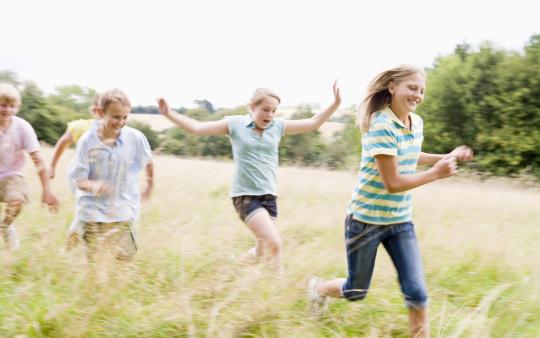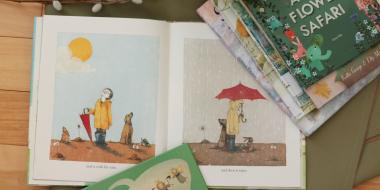As I walked into Toronto’s Trinity-Bellwoods Park at 11 am on Earth Day, April 22, 2018, the excitement in the air was palpable. Mothers, fathers, and couples all with children, toddlers, and infants in tow waited in line, eager to enter the POP-UP Adventure Playground specially created for the day by Earth Day Canada (EDC).
Trinity Bellwoods has baseball diamonds, volleyball courts, a wading pool, off-leash dog walking, and a children’s playground with factory-perfect slides and swings and many other manufactured things amenable to outdoor activity. But today there was no lineup for any of that. They were there to experience the magic of the POP-UP Adventure Playground that Earth Day Canada play-workers and volunteers had built.
Building a playground with loose parts
Actually, “built” is a little misleading. The POP-UP Adventure Playground, situated in a lavishly treed picnic area of the park, was creatively littered with “loose parts” — an eclectic collection of seemingly arbitrary recycled and upcycled materials. Rope, cardboard boxes, milk crates, tires, old clothes, variously sized wooden spools, cardboard tubes, pots, pans, cups, ice trays, ladles, spoons, shovels, spades, old electronic keyboards, and cell phones were all strewn about the area — which included a huge sand pile — so that children could discover, choose, and use them as they pleased during unstructured play.
As soon as the first wave of children hit the playground their imaginations took over. Some hit the sand pile and started digging, making shapes with buckets and boxes, and tobogganing. It was remarkable to me how much fun children could have simply digging into the sand, feeling it flow between their fingers, pouring it from one container to another and making shapes. I knew they were having fun because their activities were self-directed: no one was telling them what to do. They were free to change activities whenever they wished. And they kept doing it simply because they wanted to.
To better understand what I was seeing, I chatted with some parents who, like me, were watching the children play from a distance.
Alice’s adventures in the Earth Day playground
Shawn and Lindsay Hodgson live near the park. They had visited last year’s POP-UP Adventure Playground, but their daughter Alice was just an infant. Over the year, the parents discovered that Alice loved playing outdoors.
“She’s been sitting inside that box pouring sand back and forth from one cup into another for the last fifteen minutes or so,” Alice’s mom Lindsay said. “Every time I check on her she says, ‘Not done yet.’”
Alice had taken up residence in one room of a complex high-rise-condominium-like cardboard fort that two 9-year-old girls had created. They’d welcomed Alice and then went on to other pursuits. Finally, Shawn also decided it was time to move on. He evicted Alice from the comfort of her cardboard house and quelled her noisy protests by offering her the prospect of jumping up and down on the Springfree Trampolines.
“It’s important for kids to play outside, get physical exercise, use their imagination, develop creativity and meet other kids,” Lindsay said. “It’s a healthy and sustainable way for kids to experience nature and learn about their environment.”
The swing that Laila built
Jackie and Laila Kieser agree. Seven-year-old Laila and her mother are ardent nature lovers. Laila developed her love of nature and the outdoors from watching her parents install raised planter beds to create a completely edible backyard in their home on the Lakeshore. In fact, Jackie says, Laila maintains her own planter box and contributes her fair share to various edible crops grown at their home. Today, they decided to take a trip and spend the day at EDC’s POP-UP Adventure Playground.
The first thing Laila wanted to do was build a rope swing. She had an idea, but was not quite sure she could actually implement it. She found a long rope and a very tall tree with a strong horizontal branch. The problem was throwing the rope high enough so that it would hang over the branch. She tried. The result was far from successful. She asked her mom to try. Mom suggested that it might be a good idea to tie a weight to the end of the rope. Laila found a piece of tubing that would do the trick. Then mom tried. Closer. But no luck. Then she asked her mom to stand on a milk crate and try. Better, but not by much. Then Laila asked me.
The swing-building assistant
“Excuse me, sir. Can you please help me throw the rope to make a swing?” she said. “You’re much taller and stronger than both of us.”
Charmed by the flattery, I gave it a shot. No luck. But I came close enough to make further attempts worthwhile. Luckily, Eddie Belanger and his 4-year-son Ted walked by. Ted had been making pies in a mud kitchen nearby and had become fascinated by the repeated efforts to throw the rope. They lived in the neighbourhood and were on their way home from their regular Sunday morning music lessons when they decided to visit the POP-UP Adventure Playground. Eddie tried and failed twice. But his third try, much to everyone’s relief, was successful. Just. Barely an inch to spare. But it was enough.
“When I was a kid, these were the kinds of activities that kept us happy for hours on end,” Eddie said. “We were left to wander around seeking our own adventures, solving our own problems and learning life lessons as we went. These activities helped us develop character; it is how we acquired common sense. And it cost us nothing.”
Then came the challenge of getting the short end of the rope within reach of the ground. Laila discovered that if she jiggled and waved the rope just right she could get it in the right position. Mission accomplished. Almost. Laila then found a piece of cardboard tubing to serve as a seat and threaded the rope through it. Then came the biggest challenge of all — tying a knot that was strong enough to support Laila’s weight. Jackie volunteered to tie the knot and Layla started swinging happily. Two or three swings later she realized that the rope was cutting through the cardboard. Her swing was not as durable as she needed it to be. So she went in search of a solution, found some soft sponge slats and used them as padding between the rope and the cardboard. That did the trick. And the party started. Laila, Ted, and a steady stream of children became fast friends on the swing.
“Problem-solving is an important life skill for children. And the earlier they acquire it, the better.” Jackie said. “If Laila shows the perseverance and resourcefulness to pursue a goal she has set for herself, then it is my duty as a parent to be as helpful and supportive as possible. But standing by, hovering, and solving every problem she encounters does not prepare her for responsibilities as an adult.”
Laila eventually left the swing for adventures on the Springfree Trampoline sand pile and points beyond, but her swing remained a popular attraction for visitors for the rest of the day.
End of day clean-up
By 4:00 p.m., the playground was still abuzz with activity. Lines for the trampoline were just as long as ever and many people I had met and some faces I had seen hours before were still there. But it was time to go home. All the loose parts that had been liberally scattered throughout the day had to be cleaned up. EDC play-workers sprang into action, gradually removing unused items and placing them by the side of the road to be loaded into vans and taken back to EDC.
Suddenly, the focus of play activity changed. As soon as the children realized that clean-up was in progress, they volunteered to help. Instead of rolling spools and tires aimlessly about, the children rolled and carried their toys to the collection area, making as many trips as it took to leave the park spotless. In 30 minutes or so the job was done.
“Even cleaning up was fun,” said 5-year-old Violet, whose mother Serena had driven her an hour from North York to experience the Springfree trampoline for the first time. “I liked jumping on the trampoline, but I loved playing dress-up and the mud kitchen more.”
Want More POP-UP Adventure Playgrounds?
With just over one thousand registered visitors for the day, the Trinity-Bellwoods POP-UP Adventure Playground was clearly a success. But outdoor play should be an everyday experience. And EDC is working hard to make unstructured outdoor play part of our daily lives in our schools, communities, and on the streets of our neighbourhoods.
EDC is planning to reach twenty thousand children this year with enriched outdoor play opportunities. And we would love it if you could help. Here are some ways to get involved:
Organize, support or promote POP-UP Adventure Play in your community
Earth Day Canada hosts POP-UP Adventure Play events throughout the year in various parks and community spaces across Toronto. Keep watching our website for our next planned event and be sure to join us. We would also be happy to support an event in a park near you. If you would like to organize a POP-UP Adventure Play event in your community, Earth Day Canada would be happy to help. Contact us by email for details: info@earthday.ca.
Help us source and curate loose parts
Successful Adventure Play relies on a steady, generous supply of loose parts. If you would like to donate loose parts or are connected with an organization or enterprise that has access to loose parts we would love to hear from you.
More stuff you can do…
Visit Earth Day Canada – EarthPLAY to find out more ways to get involved!









